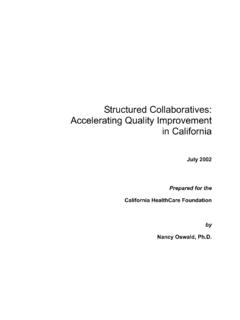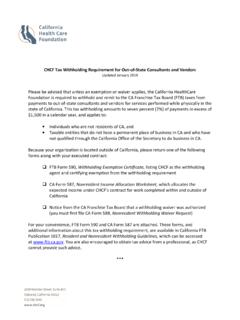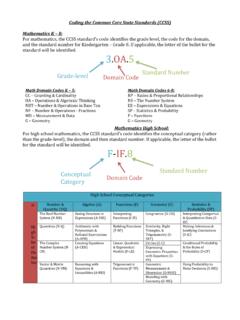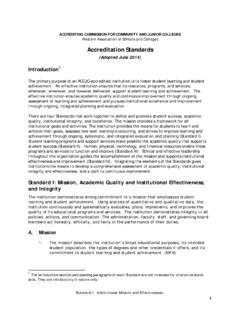Transcription of California's Nurse Practitioners: How Scope of Practice ...
1 SEPTEMBER 2018 california s Nurse Practitioners: How Scope of Practice Laws Impact Care 2 california Health Care Foundation Contents 3 Overview of the ProfessionNurse Practitioner EducationPractice Oversight of Nurse Practitioners in CaliforniaOverview of Regulations in Other StatesRecent Changes in Other States 7 Examining the Evidence for Practice Expansion: A Summary of ResearchAccess to CareQuality of CareProductivity and Cost of Care 13 AppendicesA. The Landscape of Nurse Practitioners B. State Regulations Requiring a Transitional Supervised Period of Practice 20 EndnotesAbout the AuthorJoanne Spetz, PhD, is associate director of research at Healthforce Center at UCSF. She is also a professor at the Philip R. Lee Institute for Health Policy Studies, Department of Family and Community Medicine, and the School of Nursing at UCSF. About Healthforce Center at UCSFH ealthforce Center at UCSF prepares health care organizations for success by combining a deep understanding of the issues facing their workforce with the leadership skills to drive progress.
2 They work with foundations, hospitals, delivery systems, organizations, and individuals to ensure more effective health care delivery and to inform health care policy. Their efforts are focused in the core areas of leadership pro-grams and workforce research. Learn more at About the FoundationThe california Health Care Foundation is dedicated to advancing meaningful, measur-able improvements in the way the health care delivery system provides care to the people of california , particularly those with low incomes and those whose needs are not well served by the status quo. We work to ensure that people have access to the care they need, when they need it, at a price they can informs policymakers and industry lead-ers, invests in ideas and innovations, and connects with changemakers to create a more responsive, patient-centered health care more information, visit THIS SERIESThis paper is one of a series that examines the Scope of Practice of selected california health professions.
3 The series looks at professions discussed by the california Future Health Workforce Commission and its subcom-mittees and workgroups during spring and summer of 2018. Each brief begins by describing the profession, including its legally permissible Scope of work, and educational requirements. The brief then outlines how california s permissible Scope of Practice compares with that of other states and provides a summary of research studies on the impact of the profession s Scope of Practice on access to care, care quality, and costs. Finally, it summarizes demographic characteris-tics, Practice settings, and geographic distribution. Visit to learn s Nurse Practitioners: How Scope of Practice Laws Impact Care california is 1 of 28 states that restricts Nurse prac-titioners (NPs) by requiring that they Practice and prescribe with physician oversight, and it is the only western state with this requirement.
4 A large body of research has linked such restrictions to lower supply of NPs, poorer access to care for state residents, lower use of primary care services, and greater rates of hos-pitalizations and emergency department visits. Although proponents of Scope of Practice restrictions argue that physician oversight is necessary to ensure quality of care, dozens of studies demonstrate both that the quality of NP care is comparable to that of physician care, and that there is no difference in the quality of care when there are no physician oversight requirements. Finally, several studies have found that full Practice authority for NPs is associated with lower costs of paper describes the regulations that govern the Scope of Practice for NPs in california and in other states, and summarizes recent research on how these laws impact of the ProfessionNurse practitioners (NPs) are registered nurses (RNs) who have completed additional education to prepare them to deliver a broad range of services including the diagno-sis and treatment of acute and chronic Nurse practitioners trace their history to the late 1950s, when RNs with clinical experience began to collaborate with physicians in the delivery of primary care, particularly in rural areas.
5 Nurse practitioners are one of four catego-ries of advanced Practice registered nurses (APRNs): NPs, certified Nurse -midwives (CNMs), Nurse anesthetists, and clinical Nurse specialists. NPs provide a broad array of health services, including taking health histories and performing physical exams, diagnosing and treating acute and chronic illnesses, providing immunizations, performing procedures, order-ing and interpreting lab tests and x-rays, coordinating patient care across multiple providers, providing health How Scope of Practice Is Modified in california Scope of Practice laws establish the legal framework that controls the delivery of medical services. The reach of these laws encompasses the full range of licensed health professionals ranging from physicians and physical therapists to podiatrists and dental hygienists. Scope of Practice laws govern which services each category of licensed health professional is allowed to provide and the settings in which they may do few exceptions, Scope of Practice statutes are set by state governments.
6 State legislatures consider and pass the statutes that govern health care practices . Regulatory agencies, such as medical and other health professions boards, implement the statutes through the writing and enforcement of rules and laws and regulations vary widely from state to state. Some states allow individual professions broad latitude in the services they may provide, while others employ strict limits. The nature of the limitations can either facilitate or hinder patients ability to see a particular type of provider, which in turn influences health care costs, access, and large body of research has linked restrictions on Scope of Practice to lower supply of NPs, poorer access to care for state residents, lower use of primary care services, and greater rates of hospitalizations and emergency department Health Care Foundation recent development in NP education is the establish-ment of the Doctor of Nursing Practice (DNP) degree, which is offered by an increasing number of nursing schools.
7 However, the number of NPs educated in these programs is small thus Oversight of Nurse Practitioners in CaliforniaIn california , NP Practice is governed by the state Nurse Practice The Board of Registered Nursing has pro-mulgated regulations that require the NP to work under standardized procedures for authorization to perform overlapping medical functions (CCR 1485).7 This regu-lation requires that NPs work under collaboration with a physician and adhere to standardized procedures devel-oped through collaboration among administrators and health professionals, including physicians and surgeons. california NPs must obtain additional certification from the BRN to furnish (prescribe or order) drugs or devices under standardized procedures developed with the supervising physician and As collaborators, physicians take legal responsibility for the NP s Practice and are expected to determine the appropriate level of supervision, communicate regularly with the NP, and oversee the NP s Practice and quality of care.
8 More than half of NPs in jobs with an NP title in california report that they are always ( ) or almost always ( ) involved in the development or revision of standardized procedures. Nearly 8% of NPs report never having a voice in the development of stan-dardized are no rules regarding proximity of the physician to the NP, and thus a physician can provide supervision remotely even from hundreds of miles away. In 2017, of california NPs reported that their collaborating physician practiced in the same location they did, while of NPs indicated that their collaborating physician was at another Practice or There are no data regarding the share of california physicians who formally collaborate with one or more NPs or the share who are willing to collaborate with NPs. One specific area of regulation concerns the prescribing of buprenorphine for the treatment of opioid use disorder in office settings.
9 Since 2002, buprenorphine can be pre-scribed in office-based care settings by a provider who education and counseling, and prescribing and manag-ing medications and other therapies. The Veterans Health Administration reports that the roles of NPs are similar to those of physicians in their system,2 and NPs are a key source of care in community health centers and Nurse -managed health centers For a detailed look at NP demographics and Practice patterns in california , see Appendix A. Nurse Practitioner EducationThe first formal education program for Nurse practitioners was established at the University of Colorado in 1965 with a focus on the delivery of primary care in rural The program was codesigned by a physician and a Nurse . This and other early NP education programs conferred certificates, and many of the initial graduates of these programs had received their RN education in hospital-based diploma programs.
10 The california Board of Registered Nursing (BRN) began certifying NPs in 1985, and all states now certify or license NPs. Forty-five states and the District of Columbia require completion of a master s, postgraduate, or doctorate degree from an accredited NP program, and then certifi-cation from a nationally recognized certifying body such as the American Academy of Nurse Practitioners or the American Nurses Credentialing NP certification in california can be obtained by successful completion of an NP education program that meets BRN standards, or by certification through a national organization whose standards are equivalent to those of the BRN. There are 23 approved NP programs in california . Since January 2008, california requires that new NP applicants who have not been qualified or certified as an NP in california or any other state possess a master s degree in nursing, a master s degree in a clinical field related to nursing, or a graduate degree in nursing, and complete an NP pro-gram approved by the board.

















